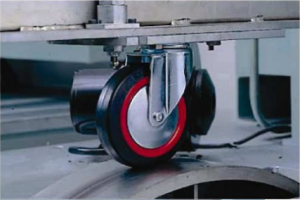The test is generally y used to confirm fatigue life of Caster Wheels used on Material Handling Equipment (for example Trolleys, Carts, Cages and other manual driven equipment).
y used to confirm fatigue life of Caster Wheels used on Material Handling Equipment (for example Trolleys, Carts, Cages and other manual driven equipment).
There are typically two different versions of the Dynamic Drum Test in which a new castor wheel design should be tested. These tests simulate the performance of the wheel
under “real world” usage and determine levels of wear and ultimate failure time scale.
What is the Dynamic Drum Test?
The Testing is conducted by attaching the Castor to a hydraulic ram which places the Castors tire into contact with a large drum, typically 1 meter in diameter. The hydraulic ram places a force equal to the maximum load that the castor can carry. The Drum rotates at a set speed (which can be altered by a variable speed motor). The rotation of the drum rotates the Casters Wheel and simulates the movement a Castor would see during normal use.
This is a relatively simply test. The Castor is mounted to a hydraulic ram and a force equal to the maximum capacity of the Caster Wheel is applied. The Drum is then rotated at a calculated speed, depending on the diameter of the wheel, which rotates the wheel at 1.1m/s.
The casters wheel is then rotated for 8 hours, equivalent to 31.7 kilometres, or until failure, whichever occurs first
A failure is considered to be a change in properties that would affect the minimum level of performance required, for example excessive wear.
The primary failure modes that are to be expected are wear of the tire (particularly rubber castors) and failure of bearings, most commonly in the wheel but also of the swivel ballrace.
Temperature readings are also taken throughout the test using non-contact infrared readers to ensure the materials maximum temperature is not exceeded. If the wheel temperature is exceeded, it is determined as a failure.
Similar to the Endurance Test, the Castor is mounted to a hydraulic ram, and contact is made with the rotating drum at a speed of 1.1m/s.
Steel plates are mounted to the drum, in which the Casters wheel will roll over every 6 meters in order to simulate obstacles in the real environment. Typically the steel plates are between 1mm and 4mm thick depending on the diameter of the caster wheels.
The force of the hydraulic ram is applied for 3 minutes and then reduced by 25% for 1 minute to simulate changing loads that a Caster may see during normal usage.
Again, temperature readings are taken to measure the materials temperature, which are expected to be higher due to the impact. It is most typical during an obstacle test to observe failure due to heat build up of rubber casters or fracture of plastic casters.
After 2 hours the test is stopped and the caster wheel is inspected for wear and failure. In order to pass the test the Castor and Wheel should be in perfect working order, with only cosmetic damage allowable.
Bulldog Castors uses these tests to ensure performance of products for the most demanding of applications. The application in which a Castor wheel is used dictates the ISO standards to follow, however the above is an extremely common test.
These tests allow Bulldog to benchmark the products we supply against other competitors and also to provide evidence to clients that our wheels can perform to a satisfactory standard.
Bulldog pride themselves on offering high quality castors, at affordable prices and the very best technical expertise and customer service.
Contact us today to discuss your application or requirement on +44 (0)116 2970521 or sales@bulldogcastors.co.uk or visit www.bulldogcastors.co.uk